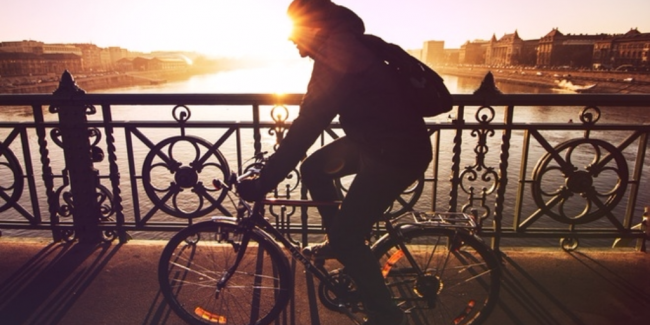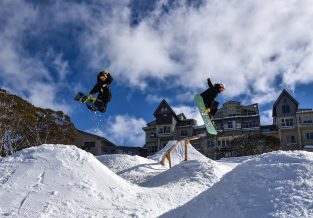Top tips for safe winter cycling!
Published on
06 Apr 2016


Written by
Roy Dookia
Consultant Physiotherapist
Call us on: (03) 9975 4133
Numb knuckles, early morning drizzle, and wet roads may not be as immediately appealing as a warm summery commute or a leisurely weekend ride. But there are some awesome benefits to riding all year ‘round, with positive impacts on your fitness, finances and the environment. Here’s our guide to safe cycling in winter.
The benefits:
Riding’s a fantastic workout at any time of year and many of the staff at Pure Physio jump on the bike for the daily commute. Regular cycling is excellent for maintaining and improving cardiovascular fitness, and it’s obviously ideal for strengthening and conditioning key muscle groups in the lower body.
The simple act of riding a bike offers a thorough workout for the gluteals, semimembranosus, biceps femoris, vastus medialis, gastrocnemius medialis and gastrocnemius lateralis.
Or, put plainly, all of the major players in your legs and hips.
Riding throughout the colder months helps to ensure that you’re engaging in a consistent level of exercise and fitness training too. So, when the big chill begins to lift and everyone starts sweating over their spring workout program? You can keep cool – you’ve been training all through the cold!
Beyond your physique, there are other clear benefits to a regular riding program.
You can save money on petrol, parking, and time spent in traffic jams (because everyone else is driving).
Or, if you choose a mix of bike and car, some progressive firms around the world are even beginning to use cycling club memberships to drive down the premiums on car insurance! Apparently, cyclists are classed as ‘better drivers’ because they have improved spatial awareness, heightened alertness on the road, enjoy a healthier lifestyle and are generally more sociable.
There are also a range of environmental benefits, too. Every bike on the road is a car off the road, which helps save on harmful emissions.
The gear:
The key to riding throughout autumn and winter is preparation. It’s not just a matter of jumping on the bike and enjoying the benefits, like it is in spring or summer. Here’s what you’ll need to succeed:
1. Lights.
The days are shorter and it gets dark earlier in the evening, which means if you’re commuting to the office or riding after work on a weekday, you’re probably going to be riding in the dark at some point. Lights will obviously help to illuminate where you’re going, and alert other cyclists and motorists to your presence. Let there be bike lights.
2. Water proof jacket or light raincoat.
This one’s pretty obvious. If it’s going to rain, you want to stay dry.
3. Layers.
At this time of year, warmer clothing is essential, especially on those longer rides. As a general rule of thumb, if you’re riding longer distance in the cold, wear a sweat-wicking underlay with a lightweight fleece for warmth.
Then, cover it with a light waterproof shell jacket. Legs usually require one less layer than your torso, so consider tights or shorts depending on your preference. Wearing warm socks and waterproof shoe covers can help prevent your toes from going numb. Cycling gloves will keep your fingers warm, while ensuring you can operate your brakes and gear levers.
4. Mud guards.
If you’re riding in wet weather, there’s going to be tire spray flicking mud and general debris up from your back wheel. Mud guards are the best way to protect your back from flecks of dirt and water.
5. Reflective clothing.
If you have a good set of bike lights (which you should!), this may not be as essential. But, you can never be too careful when the days are glum and the roads are slippery. A good set of lights and a high quality reflective jacket is the safest option. It’s the belt and braces approach, but it’s always better to take the safer route (more on taking the safe route when we get to riding techniques).
Wearing appropriate reflective and bright coloured clothing will help attract the attention of other road users and ensure they give you appropriate space on the road.
6. Pannier bags.
As a season, summer is light, it’s warm, and it’s breezy – so you can afford to travel and pack the same way. You’re going to need more gear travelling in the colder months: a change of clothes if you’re commuting, an emergency materials kit (see below), a rain jacket in case the heavens open up, a hot cup of tea (maybe wishful thinking), or anything else you might see as being worthwhile on the ride. Some people take a backpack, but a quality set of pannier bags will offer much more packing space and convenience. The additional weight can also help to provide extra traction while you’re riding on wet, potentially slippery roads.
7. Emergency bike kit.
Once you’re acclimatised to it, riding in the wet can be amazing: it’s fresh and invigorating to work out in the cascading showers. One thing you never get used to though? Walking a damaged or dysfunctional road bike through the rain. If you’ve got a pump, some spare tubes, a patch kit and some basic tools handy (shifter, Allen key), you should be able to handle any issues that pop up along the way.
The techniques:
1. Know the conditions and ride accordingly.
If the road is wet, it’s likely to be slippery in parts. Be especially careful when riding on any slick surfaces – tram tracks, sewer hole covers, gutter grates, electrical covers, and man holes can be particularly hazardous. Balance caution with confidence on the road and avoid riding too close to the gutter. Ride at a safe distance from parked cars to reduce the risk of having a car door open in front of you.
In general, try to ride more cautiously and conservatively than usual. Try to be aware of highly congested areas or traffic bottlenecks and take alternate back streets, or routes that are friendly to cyclists, with wide, bike-specific lanes. Plan your path and stick to it.
2. Predict, and be predictable.
Learn to anticipate other road users’ behaviours (motorists, pedestrians and other cyclists). Even if they regularly do the wrong thing, familiarise yourself with the behaviours and attempt to cater to them. For example, if you’re travelling along a busy pedestrian thoroughfare, remember that people may step out without looking for cyclists and slow the pace down slightly. Make sure you signal whenever you’re turning corners or changing positions in a lane. Try to avoid stopping abruptly – you could skid out and lose control if the surface is slippery, or there could be another cyclist behind you.
3. Pump the brakes.
Stutter breaking can help you to slow down on slippery surfaces while ensuring you avoid skidding. Instead of slamming on the brakes as you approach a stopping point, apply the brakes in short, and sharp bursts to gradually decrease your pace with more control. On wet surfaces, stutter braking can also reduce the distance it takes you to stop if you’re travelling quickly.
4. Approach corners carefully.
It’s much easier to slip out when you’re turning or leaning in to a corner than when you’re travelling upright with full momentum. Take every corner slowly and carefully, and try to remain as upright as possible throughout the turn.
5. Try to keep your weight on the back wheel.
Staying seated (instead of standing up for extra power while pedalling) will keep your weight distributed more evenly and help with improved traction on slippery surfaces. It also offers great stability and encourages a slower riding pace, which are both going to be beneficial in keeping upright and staying safe.
6. Look after your bike.
Cleaning and servicing your bike regularly will keep it in good working order and reduce your risk of mechanical failure. Make sure your brake pads have enough left on them and your brakes are adjusted so that you can stop when you need to, especially in the wet.
Keeping your chain clean and appropriately lubricated will ensure you are not having to replace expensive parts and will make cycling much easier. Don’t forget to check your tyre pressure. As the weather and road conditions change, ensure your tyres are going to keep you upright on the road.
7. Prevent common cycling injuries.
Cycling injuries occur as a result of an accident or fall from a bike or as a result of repetitive time on the bike. The most common cycling injuries we see in the clinic are knee, lower back and neck pain.
Having your position and posture on your bike assessed can reduce the chances of developing aches and pains and this is a service we offer at Pure Physio. It is often as simple as altering your saddle height or position to get you back on the road pain free. Following your assessment a treatment plan can then be devised to help improve posture, strength and efficiency to get you back to your best in the saddle.
Stretching or releasing muscles with a foam roller or ball after a ride will help reduce muscle tightness and tension. Strengthening key muscle around the pelvis, hips and legs can not only improve cycling performance, but help reduce the risk of some injuries.
***
Riding in winter is a great way to maintain fitness, gain access to time-neutral exercise (if you’re commuting), and enjoy the fresh winter air.
Remember to plan ahead, prepare, and keep safety as your number one priority. And, if you’ve got any handy tips or hints of your own that we haven’t covered, let us know – we’d love to hear from you in the comments!
About the Author
Roy Dookia — Consultant Physiotherapist
Roy is a New Zealand trained Physiotherapist, completing his degree at the University of Otago in 2007. Roy is very holistic in his treatment approach and considers contributions from all parts of the body when resolving injuries.


